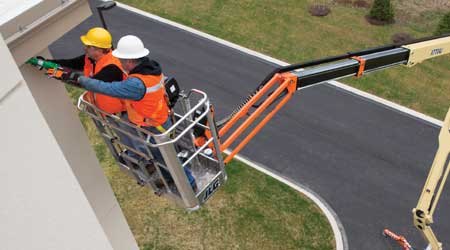Aerial Work Platforms: Lifting Productivity
Part 1 of a 3-part article on aerial work platforms
Aerial work platforms enable maintenance and engineering technicians to efficiently perform a range of tasks in hard-to-reach areas of institutional and commercial facilities. One proven way managers can ensure both efficiency and worker safety during a project is to determine the type of lift equipment — boom lift, scissor lift, telehandler, mast lift, etc. — that is best suited for the task at hand.
By identifying key project requirements and understanding technicians’ experience with lift equipment, managers will be better able to match needs to options and deliver successful projects.
A project’s requirements go a long way in determining the features and functions of aerial lifts that departments need. Requirements fall into six groups: personnel; horizontal movement, surface, and obstacles; vertical movement and obstacles; tools; portable equipment; and material. Managers can use these six groups as a checklist to identify all the project requirements that will affect lift selection. By considering all of them, managers can take a comprehensive approach to planning effective, safe work in hard-to-reach areas.
Personnel. If the job requires one worker at height, a bucket lift will do the job. When a job requires several workers at the elevated job site, the best choice is a scissor lift, which has a large platform. Project planning should include reminders for all personnel to wear proper personal protective equipment (PPE), such as a hard hat, safety glasses or goggles, earplugs, gloves, safety shoes, and a respirator, as required. Planning also should include a pre-job inspection to ensure all safety features, such as backup warning lights and the horn, are in place and work properly.
Movement, surface and obstacles. While scissor lifts generally have larger platforms, they tend to only reach 20-50 feet and are less maneuverable. Boom lifts can reach up to 130 feet, are more maneuverable, but cost more.
If the job is changing interior lamps in high-bay fixtures from a smooth floor, such as a gym, or exterior smooth surface such as a parking lot, a solid-tire scissor lift of appropriate height when extended will navigate through doors and accommodate the workers, spare lamps, and tools needed to open fixtures. If the job requires horizontal reach to extend above obstacles blocking the way, a motorized platform extension might be best for short horizontal reach. For longer reach, a telescoping boom lift will do the job.
If the work location is behind obstacles blocking horizontal and vertical access, an articulated boom lift with two knuckles on the boom can help technicians reach up, over, and down behind the work area. If a job is inside or outside on an irregular, sloping, wet or muddy surface, managers should look for units with balloon tires and balance controls for traction and to prevent tipping.
Instruments on the control panel can measure the tilt and slope, as well as stop further movement if the lift approaches a dangerous tilt. Without these controls, the operator has to judge when the combination of load, reach, height, and tilt are at a danger point. In such situations, human error has caused serious accidents, injury, and even death.
Tools, equipment and materials. If the job requires power tools or welders, either workers will need to use battery-operated tools or the lift needs electrical outlets. In the case of welding equipment, the platform also must have enough outlets and space, depending on whether electric or oxy-acetylene gas is used. If workers are transporting material for the job via the lift, the job will require additional space planning, and it might require alternate means, such as a telehandler, for getting the material up to the job site.
To ensure safety while on the lift, workers need to leave enough space on the platform so they can move inside the platform railing. They should not perform work outside the railing, even if they use fall protection. With the worker outside the platform, with fall protection on, a sudden movement of the lift can result in the worker swinging under the platform and hitting the underside with enough force to cause serious injury or death.
Related Topics:












